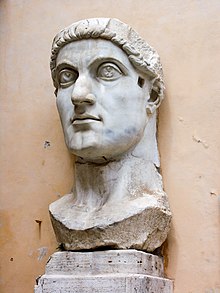Constantine
|
|||||
|---|---|---|---|---|---|

Marble head representing Emperor Constantine the Great, at the Capitoline Museums
|
|||||
| 57th Emperor of the Roman Empire | |||||
| Reign |
|
||||
| Predecessor | Constantius I | ||||
| Successor | |||||
| Born | 27 February c. 272 Naissus, Moesia Superior, Roman Empire (present-day Niš, Serbia) |
||||
| Died | 22 May 337 (aged 65) Nicomedia, Bithynia, Roman Empire |
||||
| Burial | Church of the Holy Apostles, Constantinople | ||||
| Spouse | |||||
| Issue | |||||
|
|||||
| Dynasty | Constantinian dynasty | ||||
| Father | Constantius Chlorus | ||||
| Mother | Helena | ||||
| Religion |
|
||||
| Full name | |
|---|---|
| Flavius Valerius Aurelius |
Constantine the Great (Latin: Flavius Valerius Aurelius Constantinus Augustus;Greek: Κωνσταντῖνος ὁ Μέγας; 27 February c. 272 AD – 22 May 337 AD), also known as Constantine I or Saint Constantine (in the Orthodox Church as Saint Constantine the Great, Equal-to-the-Apostles), was a Roman Emperor from 306 to 337 AD. Constantine was the son of Flavius Valerius Constantius, a Roman Army officer, and his consort Helena. His father became Caesar, the deputy emperor in the west, in 293 AD. Constantine was sent east, where he rose through the ranks to become a military tribune under the emperors Diocletian and Galerius. In 305, Constantius was raised to the rank of Augustus, senior western emperor, and Constantine was recalled west to campaign under his father in Britannia (Britain). Acclaimed as emperor by the army at Eboracum (modern-day York) after his father's death in 306 AD, Constantine emerged victorious in a series of civil wars against the emperors Maxentius and Licinius to become sole ruler of both west and east by 324 AD.
As emperor, Constantine enacted many administrative, financial, social, and military reforms to strengthen the empire. The government was restructured and civil and military authority separated. A new gold coin, the solidus, was introduced to combat inflation. It would become the standard for Byzantine and European currencies for more than a thousand years. The first Roman emperor to claim conversion to Christianity, Constantine played an influential role in the proclamation of the Edict of Milan in 313, which decreed tolerance for Christianity in the empire. He called the First Council of Nicaea in 325, at which the Nicene Creed was adopted by Christians. In military matters, the Roman army was reorganised to consist of mobile field units and garrison soldiers capable of countering internal threats and barbarian invasions. Constantine pursued successful campaigns against the tribes on the Roman frontiers—the Franks, the Alamanni, the Goths, and the Sarmatians—even resettling territories abandoned by his predecessors during the Crisis of the Third Century.
...
Wikipedia
